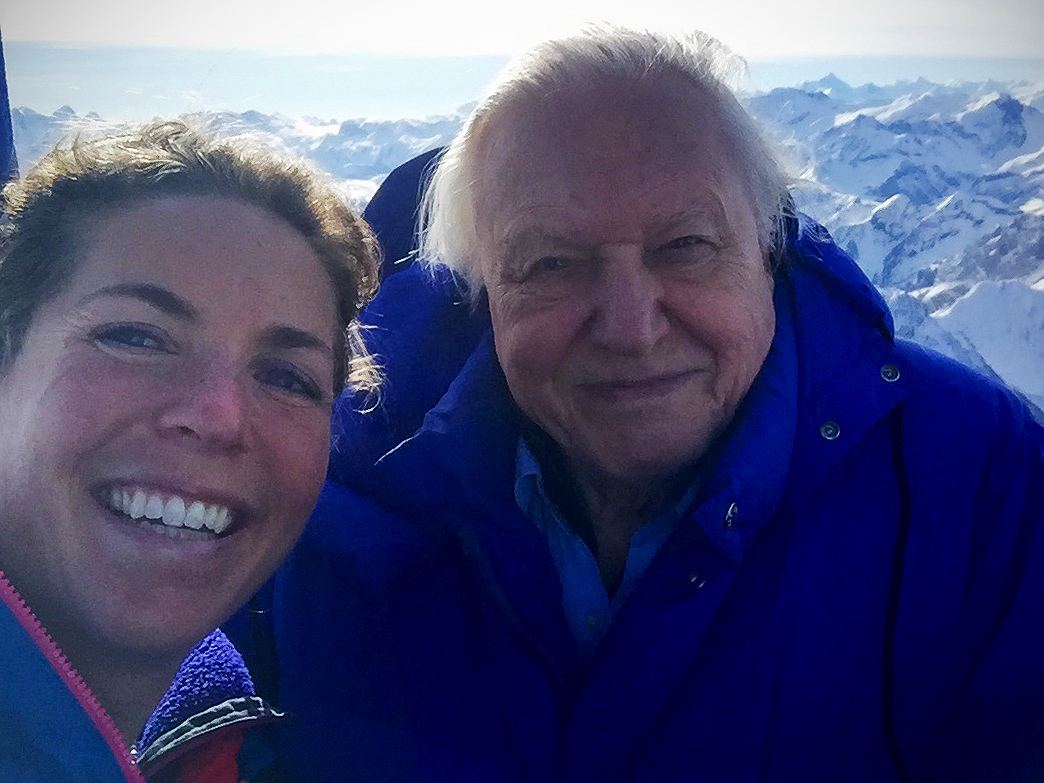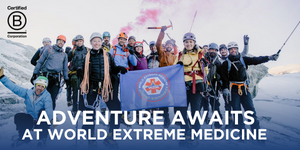Dr Lucy Obolensky / GP and Expedition Doctor / UK
At Adventure Medic HQ, we have a near-religious devotion to nature documentaries and BBC Natural History Unit series in particular. With each incredible location, we wondered – who was the lucky medic? How did they get that gig? More than anything, how would they feel being the doc responsible for Sir David Attenborough on the latest Planet Earth II series?? So, we tracked her down. In our last article before the Christmas break, this is Dr Lucy Obolensky on the highs and lows of look after a 90-year-old National Treasure in a balloon.
Filming with Planet Earth II
It’s a beautiful sunny morning in Chateaux D’Oex in the Swiss Alps and the perfect morning for a hot air balloon ride. A hot air balloon ride with Sir David Attenborough.
I’ve been involved in remote and expedition medicine for over 15 years, initially leading expeditions for school groups, setting up and running my own expeditions for friends and colleagues, and now working for larger expedition companies. Through teaching at the Royal Geographical Society I’ve had the pleasure of training many camera crew who travel to remote locations for their filming. Often you don’t get to travel with them however, in recent years I’ve been lucky enough to get invitations to join some of their expeditions as team medic. The most exciting ones being those with the Planet Earth II team and Sir David Attenborough. I was lucky to get this gig. I’d just had a little girl earlier in the year, so my colleagues at Phoenix Expedition Medicine had taken the other Planet Earth II jobs, including my colleague James Moore who’d been camping for 16 days in penguin shit on Zavodovski island. Win some, lose some.
Being responsible for a National Treasure
Naturally, I was thrilled at the opportunity to meet and to work with Sir David, but equally slightly nervous that this could be a career-ender should anything go wrong! I needn’t have worried. Sir David was incredibly fit for his age, and I was there both for him and for the wider BBC team undertaking the balloon shoot.
My main role was sourcing and putting together the medical kit. I was quite used to this from my past expeditions and, as ever, the main things to consider were:
- Where were we going?
- What could we carry with us?
- How we could get to the nearest definitive medical care?
Switzerland has an excellent pre-hospital care system with a network of well-supported hospitals. It was worth taking full resuscitation equipment and airway kit, very different to my next trip to Antarctica remote from any form of definitive medical care. I tend to take quite a lot of time over pre-departure medical questionnaires, and explain to the entire team why I need as much information as possible before the trip. This includes their thoughts on treatment escalation plans. Sometimes the team can be surprised by these kinds of questions, however these discussions are important when you are doing high risk activities, and even more so if you are in remote locations with nonagenarian naturalists.
Up, Up and Away
Whilst the team were preparing the balloon, I ran some errands, readied my kit and stowed it in the balloon’s basket. I had a chat with the balloon pilot about emergency landings (apparently, all balloon landings are ‘controlled emergencies’!) and where we could perform resuscitation should any of the crew have collapsed at altitude.
‘Good flexibility and steely quadriceps’
Job description.
Finally, it was time to go. Before I knew it we were off and away flying up to 10,000 feet above the Swiss Alps. It was so quiet and peaceful. Not for long however! Soon the chopper arrived and we had to crouch down inside the balloon, unseen for all the helicopter shots. ‘Good flexibility and steely quadriceps’ were definitely NOT on the job description and soon my thighs were burning and toes numb from squatting for so long. I caught the cameraman’s eye and we had a quiet little snigger together at the absurdity of the situation.
Then at last we could stand up again as the helicopter disappeared across the mountains. The producer and camera man filmed Sir David giving his lines for the opening scenes, along with some great shots of him looking out of the balloon across the Alps. Finally, it was time to land. Being pretty fit I was ready, braced next to Sir David thinking I’ve definitely got this covered. The next thing I knew, we’ve hit the ground unexpectedly and I’ve pretty much toppled on top of the 90-year-old National Treasure. Whoops!
That afternoon, we had a bit of down time whilst the team went through the footage. I made myself useful, getting coffees and moving and stowing bags, but was also fortunate to have the opportunity to spend some time with Sir David. He was absolutely wonderful; incredibly passionate and knowledgeable about his work and yet so humble. He treated everyone with utter respect and kindness, from the executive producer to the waiter who served us coffee.
He seemed not to really understand this tidal wave of adoration for him. I tried to explain saying ‘I think Sir David, it’s because you span generations. My nine-year-old nephew, my husband and my granny were all equally as excited about this opportunity as I was.’ He smiled but moved on to tell me about his latest role in sustainable energy. His position will be to encourage countries to work together to achieve the sustainable development goals, in particular to find a solution to the storage of sustainable energy. It was fascinating.
Flying too high
The only hairy moment came (typically) when we were least expecting it, yet in hindsight it was entirely predictable. With the balloon flight over and everyone breathing a sigh of relief, we were then going to ‘pop up’ the Aiguille du Midi in Chamonix for a bit of evening filming. The cable car takes you from the centre of Chamonix up to 3,842m in the space of about ten minutes.
Almost immediately after arrival the entire filming team were feeling the effects of altitude, including Sir David. I advised the team on how to do their own PEEP pursed lip breathing and had oxygen standing by whilst we waited for the cable car to return to take us down to the middle station where the executive producer made the decision to do all the filming from there.
Lots of people think that expedition medicine is a big action, high octane job. It’s not. Mostly it is about keeping people healthy both mentally and physically. On longer expeditions, you are usually dealing with stomach upsets and the mental pressures of the trip. However, on the rare occasions that there are trauma situations or medical emergencies you have to be able to deal with them in an austere environment.
You also can’t let down your guard. I could have predicted the onset of AMS and discussed my concerns with the producer. Instead though, with the focus on the balloon flight and the Aiguille du Midi being an added extra, I rather overlooked the risk. It taught me to always be prepared, particularly in the filming industry where plans can change rapidly and on the spot.
Sir David and the team did some incredible filming on the mountain. It was a real privilege to watch them at work. When we got the last cable car down, watching dusk settle over the Alps, it was beautiful.
Dr Lucy Obolensky is the Programme Lead for the Global and Remote Healthcare Masters in Plymouth University. She combines her academic role with working clinically as a locum ED staff grade and General Practitioner. Taking the plunge to do only locum work has enabled her to enhance her own career in global health and expedition medicine. Lucy sent this article through from a ship in the Drake Passage enroute to Antartica.





